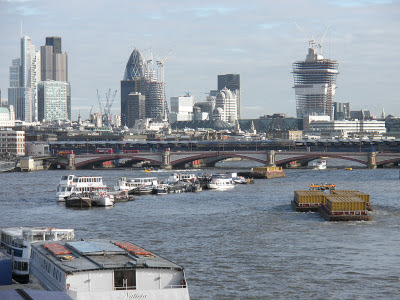The view towards the City of London from Waterloo Bridge is one of the best in London, which is one reason why it appears in the header to this blog*.
The more recent photo above shows the present state of the City's skyline, with cranes as prominent as buildings, most notably on the sites of two of the City's new towers: Rogers Stirk Harbour's 'Cheesegrater' (next to Foster's Gherkin) and Viñoly's 'Walkie Talkie' (on the right), the frame of which now begins to show us the shape of building we will be getting (in case we hadn't quite believed it).
If you've spent your adult life involved in putting up buildings, the sight of this forest of cranes should be enough set the pulse racing irrespective of what you think about the buildings. Colonel W A Starrett, author of 'Skyscrapers and the Men who Build Them' (1928), wrote that 'Building skyscrapers is the nearest peace-time equivalent of war' - if you have witnessed the level of activity at the foot of one of these sites, or at that of the nearby Shard until recently, you can see what he meant.
But the tall buildings that the cranes are putting up are even more effective at eliciting a reaction.
Fluctuating vital sign measurements are not always a good thing - a recent rant in print from Simon Jenkins about the ruination of London's skyline, along much the same lines as we have heard from him rather too often before, being a case in point.
On the other hand, you can find websites dedicated to the slightly anorakish musings of skyscrapers enthusiasts, the antimatter opposite of Simon Jenkins, who enthuse about heights above Ordnance Datum, cladding systems and all sorts.
Ruskin wrote (in the 1850s) 'Have not these words, Pinnacle, Turret, Belfry, Spire, Tower, a pleasant
sound in all your ears? ….can you really suppose that what has so much power
over you in words has no power over you in reality?' It seems unlikely that he would have approved of skyscrapers, but we can trace a path from this statement of the emotive power of verticality through Louis Sullivan's exhortation (in the 1890s) that a tall office building should be 'every inch a proud and soaring thing', to the clear intention of many of today's skyscraper architects to amaze us rather than follow the more sober route of Mies van der Rohe's towers.
It is permissible, though, to take a more sober view. London needs to grow within its borders. Paul Finch pointed out in last week's Property Week that there is no shortage of land in Greater London to allow it to do so without needing to expand into the green belt - there are oven-ready sites, which have been sitting there for a decade or two, for tens of thousands of new homes in the Royal Docks and Greenwich Peninsula. Closer to the centre, however, it is a very different story - there is the strongest demand to build, and the least room to build, partly because nearly everything is now a 'heritage asset'. I don't like the look of the Walkie Talkie at all - but even if, as I suspect, I am not alone, that's not much of a reason not to build it, when compared with the arguments in favour of doing so. The only way is up - a case that was made convincingly at this summer's excellent exhibition 'The Developing City'. Otherwise London will end up like the Paris that the tall-poppy-loppers would like it be - but not in a good way.
*(it did when I wrote this post - it was updated in 2015)
Subscribe to:
Post Comments (Atom)




No comments:
Post a Comment